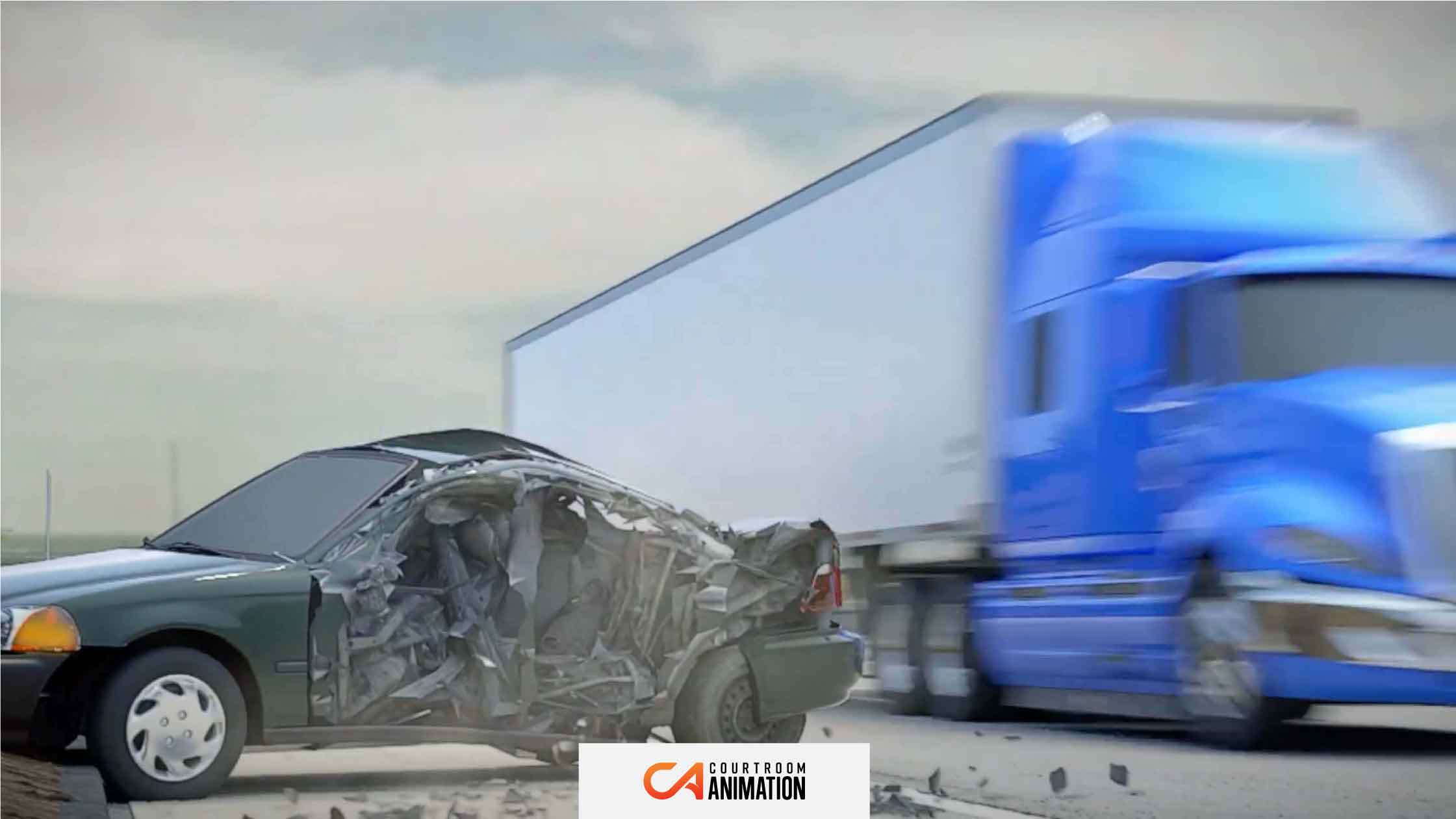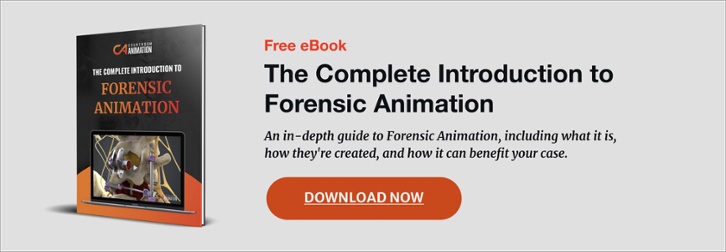
In the past few decades, attorneys relied on projectors and poster boards for explaining their key case arguments. Now, with the advancement of computer technology and visual effects, attorneys have transitioned from antiquated presentation aids, such as written depositions, to skillfully renditioned legal graphics. These court graphics are visually appealing and convey sophisticated concepts to a jury, or other viewers.
Various types of litigation cases can benefit from a legal graphic, such as personal injury, accident reconstruction, and more, no matter what stage of the legal process you are in. Any type of witness testimony, such as a licensed medical practitioner, can use a legal illustration to enhance their explanation and make it more accessible to the everyday person.
Legal graphics can also take a complex topic, such as an intricate medical procedure or scientific process, and clarify the core facets to a juror or mediator. This helps them fully understand the incident and retain any crucial information to your case.
As the adage goes, “A picture is worth a thousand words.”
How exactly can a trial graphic achieve all of these factors in court? Let’s dive into the four benefits of legal graphics for your case.
1. Simplify the Complex
Legal graphics play the important role of taking all the complexities of your case and transforming them into a digestible medium for your audience. The various factors of an incident, such as timing, lack of evidence, or various perspectives can confuse a jury or judge.
Multiple Parties
If your case has multiple parties, such as opposing eyewitness accounts, a legal animation or graphic can validate or invalidate contradicting arguments.
In this 3D animation video, you can see both the driver and pedestrian perspectives. This animation brought a realistic view to the incident and helped the court reach a settlement faster. A legal graphic can achieve the same effect.
Length of Your Case
The longer it takes to reach a settlement, the more convoluted the facts and events become. For example, if a theoretical medical malpractice case was dragged out for several months, then different doctors, treatments, and patient visits could convolute the key narrative you were trying to argue.
Unless a case reaches a settlement quickly, there is a good chance that the web of different details would make it hard for a jury to follow. A legal graphic can supply a visual explanation that can recount and remind viewers exactly what happened and when.
Working alongside an attorney and expert witnesses, our team of legal graphics experts aim to tailor your timeline to fit the facts, evidence, and strategy of any legal matter. Known as the picture superiority effect, visual ideas are easier to remember than words.
Lack of Clear Data
Some litigation cases don’t have enough evidence to quickly reach a settlement. While legal graphics are not evidence themselves, they can be used to emphasize what data is already present. If that data is also unclear or confusing, then a litigation graphic is even more useful to your case. It can explain more technical information like engineering or scientific concepts. For instance, a visual could show the inner workings of how an artery was punctured during surgery.
2. Reinforce Your Expert’s Position
Not everyone has the technical expertise to understand how, for example, one piece of metal in a car broke, and how that could influence a theoretical car crash. The many factors influencing an accident like this are complicated and not always easy for a jury to follow.
A legal graphic is an easy way to increase the efficiency of your expert’s argument. To start, your legal graphic team can partner with any type of expert brought in, such as a motor vehicle accident recreation specialist, who could ensure the trial graphic is accurate.
This legal animation video depicts exactly how the car broke down, and labels each part for unaware viewers. Even if you choose to only use a graphic, rather than a full 3D animation, the graphic can help an expert clarify their positioning by labeling complex machinery, or even parts of the human body.
With both a verbal explanation from an expert on the subject, and a convincing visual to accompany their reasoning, any unclear testimony can be greatly simplified.
3. Impact Every Phase of Litigation
Legal graphics are not limited for use only during trial. For example, both plaintiff and defense attorneys can leverage them to support their case during:
- Motion practice
- Settlement discussions
- Mediation hearings
- Focus groups
A law graphic can benefit your positioning whether the case has started, is scheduled for a later time, or a settlement has almost been reached. No matter what time you show the visual, it will help the audience remember your case’s key facts.
4. Increase Comprehension and Retention
It is difficult for a courtroom presentation to be effective if there is no visual element for the jury to absorb. It’s been scientifically proven that presentations with visual components are about 43% more persuasive than those without. Not only do legal graphics help clarify key facts to a jury, but they also help mediators, and even the opposing counsel, understand your side of the case. Once your client’s story is recreated, you have the power to depict the case at different levels of fidelity.
Whether it’s a complex medical procedure, a system schematic, architectural model, or a medical device, compelling legal graphics summarize the key themes and core arguments of your case.
Helpful tip: When it comes to submitting graphics or courtroom illustrations to be admitted to trial, it’s important that the material presents a fair and accurate representation of the evidence. Download this free legal graphic eBook to learn five easy steps that will ensure your visuals are admissible.
At Courtroom Animation, we pride ourselves on our data-accurate legal graphics and the 2,000+ cases that we have assisted.
“The jury was rapt every time we played it in court and they asked to [show] it again while deliberating. After the verdict came down, many of the jurors told us that they really liked the video.”
Lnyberg & Watkins
The Positive Impact of Legal Graphics for Your Case
No matter how big your case is or how long it lasts, a legal graphic gives you an advantage over the opposing counsel. If you have a technical case that can be hard to verbally explain, a trial graphic can clarify the details. Additionally, an expert’s perspective might make the technical or complex aspects of the case vague to the jury, or any other audience. With a 3D legal graphic, you can guide your viewers through their explanation. This reinforces their positioning in your case, which will help you reach your desired outcome for your client.
A trial graphic can be helpful in every phase of the litigation process. Even a 2D, non-animated graphic can help the jury or judge remember the key facts of your case after you have explained it. These four reasons are why legal graphics are beneficial for your case.
If you’re working on a litigation case, a legal visual aid can make all the difference. Get your no-obligation quote today and one of our team members will contact you to discuss what we can do to support your case.

Topics: